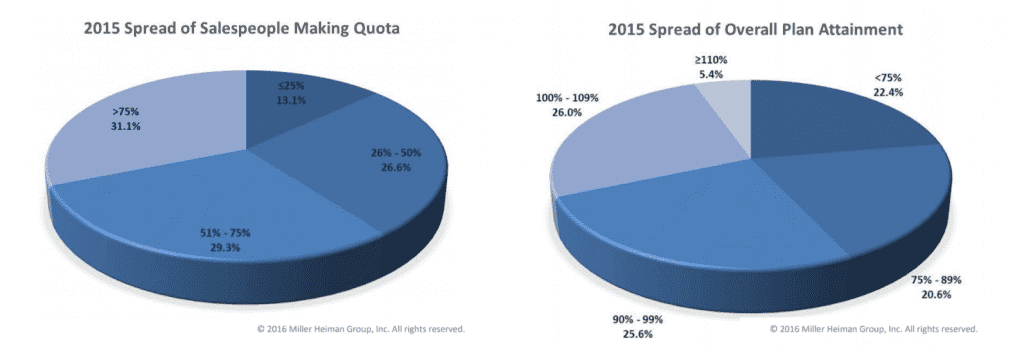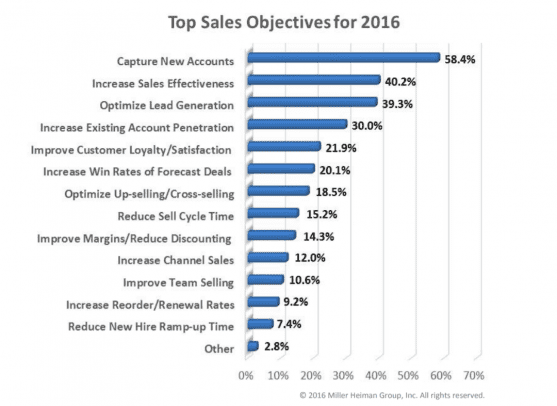The sales process is the core engine of growth for any company, which is why business owners, sales managers, analysts and thought leaders have dedicated countless hours studying optimization strategies. As marketing and sales strategies coalesce around customer-centric omnichannel engagement, companies pursuing data-driven personalized sales strategies are finding pipeline accuracy and effective oversight to be elusive targets.
CSO Insights’ 2016 Sales Performance Optimization Study assessed challenges facing sales teams and benchmarked how participant companies -- a third of whom had revenues over $50 million -- leveraged their human, technological, and strategic assets to increase the efficiency and performance of their sales forces.
The study found a total of 92.5% of surveyed firms raised their revenue targets for that year. However, the percentage of companies whose salespersons made quota was in decline (57.1%) while those at revenue plan attainment was almost static (82.7%).

Meanwhile, a majority of participants said that capturing new accounts was their chief sales goal, while increasing sales effectiveness came in second. With sales teams struggling and revenue attainment near-stagnant, how did participant companies intend to reach their elevated targets?
Moreover, as CRM technology is adopted for sales enablement, how can sales officers leverage their technology to increase sales effectiveness? What management doctrine can they employ for sales end users, and what benchmarks should they use to measure improvement?
Let’s examine.
Defining and Improving Your Sales Process
The 2016 CSO Insights study found that aside from the primary goal of adding new accounts, most sales objectives listed by surveyed companies actually depended on achieving the secondary overall goal -- increasing sales effectiveness.

Increasing existing account penetration, improving customer satisfaction, increasing the win rates of forecast deals -- these objectives are met by improving the performance per salesperson and the process overall. The sales process is a particular focus of the study. While individual salespeople combine science and artistry to close a deal, the sales process can be defined by qualitative, hierarchical stages as benchmarks for consistency, adaptability, and ultimately, performance. (In fact, CSO Insights did just that in an article published in a 2006 magazine issue of Harvard Business Review dedicated exclusively to sales.)
Increasing sales effectiveness is achievable by improving the sales process. This calls on sales officers to define their sales process (or processes) by certain criteria, and analyze it critically for shortcomings. The criteria described by CSO Insights in their 2006 article focuses on salespeople's knowledge and skills, role fulfillment by managers, involvement of subject matter experts, the proposal generating process, and your team's collaboration habits.
1. Random Process
The company lacks a single standard documented or adopted sales process. Sales processes at this stage bear common characteristics:
- Salespeople pursue deals according to what they feel must be done to advance or close opportunities.
- Managers track activities and bookings.
- Subject matter experts (SMEs) are brought in with little briefing on what needs to be covered.
- Proposals are generated by individual salespeople using past proposal efforts.
- Salespeople are not collaborative -- they don’t share winning tactics with one another.
2. Informal Process
The company presents a sales process to its salespeople and indicates they should use it; however, it lacks proper training, monitoring and enforcement protocols, or the will to use one. There are a few improvements over the previous level:
- Salespeople know there is a process; some use it as a guideline, while others map their own process.
- Managers track activities, pipeline, and bookings.
- Subject matter experts receive at least a heads up before meetings.
- Proposal templates exist, but salespeople aren’t required to use them.
- Salespeople are collaborative and willing to share ideas, but there’s no basis for group learning.
3. Formal Process
The company has a defined sales process and regularly enforces its use. It also periodically reviews the process to determine its effectiveness and incorporates changes based on the review. What happens at this stage:
- Salespeople integrate the sales process into their sales activities.
- Managers track key metrics via dashboards and reports.
- SMEs are collaboratively involved in the sales model and can identify specific topics or pain points.
- Proposal templates based on playbook guidelines are expected of all salespeople for all opportunities.
- Best practices are routinely identified and shared across the sales team.
- Visual aids (i.e., an animated sales video, infographic, chart) are used to ensure everyone involved is on the same page.
4. Dynamic Process
The company has a documented sales process that salespeople understand and employ. Its use is enforced, reinforced, and measured. Salespeople receive regular feedback on their use of the process. This is the highest level characterization of a sales process.
- Salespeople and managers rely on the sales process as the basis for their daily workflow, and it's used as a personal benchmark to measure performance.
- Managers receive proactive updates on changes in metrics as well as performance alerts for KPIs.
- SMEs continuously monitor the sales pipeline for emerging opportunities on which they can contribute insight.
- Template-based proposals are tracked throughout the sales process with relevant win/loss statistics collected.
- The CRM system is the foundation for sales and marketing alignment, social media activities, sales templates, and collaboration.
Companies’ sales processes sometimes span two or more of these levels. In fact, aspects of individual characteristics can do the same. The first step to improving the sales process depends on identifying where the team currently stands and building a framework for strengthening shortcomings in organization, communication, or coherence.
Improving B2B Customer Relationships
Defining and analyzing your sales process for shortcomings is a major part of the equation whose result is increased sales effectiveness. Another major part is improving the effectiveness of individual sales representatives. This can be measured, in part, by how your company is perceived by its customers. Is it merely a vendor? A preferred supplier? Perhaps a strategic advisor?
Improving the nature of your company and sales team’s relationship with customers requires a coordinated effort. Salespeople working as lone wolves to win accounts will not be able to muster the resources to distinguish themselves or their company while meeting their quota. Moreover, salespeople can have a number of winning traits and capabilities, yet fail to meet their overall potential because their time and attention isn’t focused on the right targets.
Sales managers who are able to direct their team towards customers’ interests and pain points will stand out compared to other vendors. This is particularly true for companies whose products or services are targeted to specific accounts at client companies. The grade of B2B customer relations, from mere vendor to a trusted partner, is as follows:
| Relation to Customer | Description of Role |
| Approved Vendor | Detailed Knowledge of Product/Service. Salespeople must have a strong functional understanding of your product or service. They must possess basic sales skills (i.e. presentation, proposals, discovery), the ability to deliver what was ordered, the ability put together an accurate bid, etc. You may have only limited contacts within the account. |
| Preferred Supplier | Knowing How Customers Use the Product. Salespeople understand the customer’s intentions for the product. They also have strong technical understanding of the product. They are able to predict how the deployed solution will function towards the customer’s goals. Your company has several points of contact within the client organization and offers accountability -- the ability to deliver within a timeframe. |
| Solutions Consultant | Understanding the Buyer’s Business. Salespeople understand the client’s business -- in other words, how the product will help the customer’s customer. Your team is able to diagnose and prescribe solutions, build rapport through effective communication, and demonstrate business acumen. You have contacts at all key levels of the account, and your team can articulate how your product can be leveraged to the client’s gain, citing past examples, case studies, industry reports, etc. |
| Strategic Advisor | Understanding the Buyer’s Industry. Salespeople are able to analyze the customer’s position within their industry and articulate the competitive advantage your product will bring. Your team communicates regularly at all key levels within the account. Your team is able to outline implementation, contribute to the client’s business plan, demonstrate domain expertise, and accelerate the buying process as required. Your company is consulted for input on strategic decisions extending beyond the actual product. |
| Trusted Partner | Understanding the Buyer’s Organization. Salespeople understand how purchasing their product influences their client’s long-term objectives. They are able to articulate substantive contributions at different stages of a long-term partnership, and bring a network of contacts and partners to complement the product. Your company proactively serves as a knowledge resource for key contacts within the account, and aligns its own objectives alongside those of key clients. |
The strategy to increasing sales effectiveness is a two-pronged approach: on the one hand, you want to define and analyze your sales process for places you can tighten the bolts, so to speak. On the other hand, you want to define your sales rep performance -- and while metrics will continue to serve as your baseline, focusing training efforts on best use of time and best practices gives individuals the space to apply the sales artistry that fits their style.
Looking for sales CRM software? Check out our comparison page for sales automation solutions.



